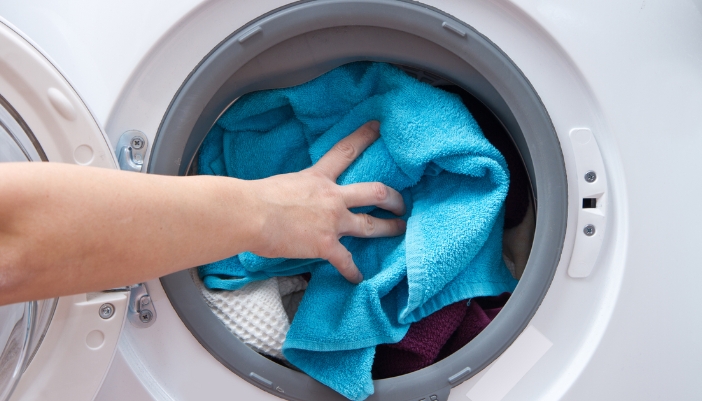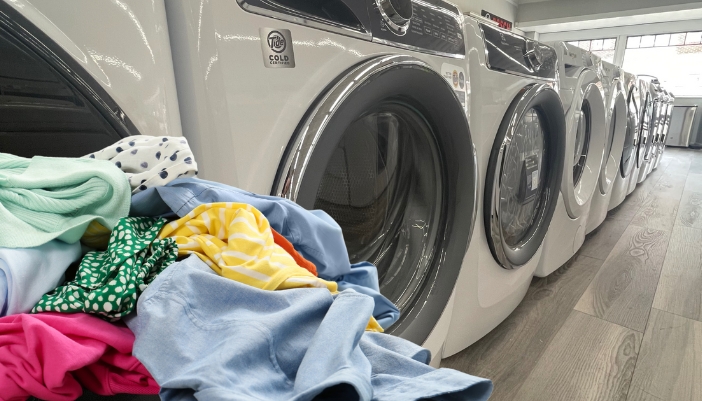Imagine a world without washing machines. Just piles of dirty laundry and the endless joy of hand-scrubbing socks. Not exactly utopia. Fortunately, someone brilliant invented the washing machine, and now you don’t have to imagine that world... as long as your washer stays in working order!
To keep your loyal laundry companion running for years to come, here are five easy steps that will help it work smarter, not harder.

1. Balance is Everything (And Not Just in Yoga)
First things first: you’ve got to keep things balanced. And we’re not talking about finding your inner peace (though that might help too). We’re talking about loading your washer correctly.
Whether you’ve got a top-load or front-load machine, the goal is the same: even distribution of clothing. Wet laundry gets heavy (especially towels and bedding).
- An unbalanced load can cause shaking, banging, and long-term damage to the motor or suspension.
- If your washer starts sounding like it’s hosting a drum circle, that’s your cue that something’s off.
To prevent this:
- Don’t overload one side.
- Mix heavy and light items with care.
- If you’re unsure, consult your washer’s manual or call in a service tech.
Your washer will run smoother—and your laundry room will stay in one piece.
2. Keep It on the Level
Balancing your load is great, but it won’t matter if your machine itself is off-kilter. Washers should sit evenly on the floor. It should not be rocking or tilting, and it definitely should not be moonwalking across the laundry room mid-spin.
Check for level:
- Most washers have adjustable feet. Use them.
- Grab a bubble level or use a leveling app if you’re fancy like that.
- Consult your manual or a pro if you're not sure what you're doing.
An unlevel machine can damage internal parts over time and increase wear on everything from the drum to your floors. A few minutes spent adjusting it now can save you a call to your local repair tech later.
3. Redefine “Full”
We get it. Laundry day isn’t exactly thrilling. So it’s tempting to shove every last sock, hoodie, and towel into the washer at once. But here’s the deal: full doesn’t mean packed to the top.
A full load of clothes is about three-quarters of the drum. That’s enough space for water and detergent to circulate, get into the fabric, and actually clean your clothes.
Overstuffing can:
- Prevent proper cleaning.
- Leave soap residue or dirt behind.
- Overwork your motor and shorten the machine’s lifespan.
Pro tips:
- If you have hard water, consider using a water softener. Mineral buildup can clog parts like the pump.
- Got pets? Toss your clothes in the dryer (no heat) for a few minutes first to get rid of fur—it’ll spare your washer’s internals.
- When the cycle ends, remove your clothes promptly and leave the door open to help dry out the drum and prevent mold.

4. Clean the Machine That Cleans
Yes, it sounds weird, but even your washing machine needs a good cleaning now and then. Just like a sponge or dish rag, it doesn’t magically stay clean while doing its job.
All the grime, soap scum, and stray bacteria from your laundry can build up inside the drum, gasket, and drain system. Left unchecked, it’ll start to smell... and possibly clog important parts.
Here’s what to do:
- Run a clean washer cycle once a month using a cleaning tablet like Affresh®.
- No clean cycle? No problem! Run a hot cycle with the tablet or a cup of white vinegar.
- Wipe the gasket and detergent drawer occasionally.
Your washer will smell better, work better, and won’t get that weird film of mystery gunk around the door.
5. Don’t Drown Your Laundry in Detergent
A little goes a long way. Detergent is super concentrated these days, and using too much doesn’t make your clothes cleaner—it just builds up in your machine and helps mold throw a party.
Here’s a good rule of thumb:
- Standard washers: 1–3 tablespoons (depending on load size).
- High-efficiency (HE) washers: 1–3 teaspoons.
Bleach? Sure, but only about ⅓ cup per cycle. Too much can corrode important parts like the gasket or the pump. Think of it like seasoning: the right amount makes it better, but too much ruins everything.
Bonus: Know Your Machine
Your washer is hardworking, loyal, and never calls in sick. The least you can do is get to know it.
- Read the manual (yes, that booklet you tossed in a drawer).
- Learn what each cycle is for.
- Pay attention to the sounds it makes. Weird noises usually mean something’s wrong.
The more you understand your machine, the easier it’ll be to catch small issues before they become big ones.
Final Rinse
To sum it all up: Don’t overload it, don’t neglect it, and don’t assume it’ll run forever without a little love. Following these five (okay, six) steps can add years to your washer’s life and help you avoid the dreaded laundry apocalypse.
Got tips of your own? Share them with us! At Shore Appliances, we love hearing from fellow appliance enthusiasts and we’re always here to help if your washer needs a little TLC.

David Dozier
Sales, Shore Appliances Inc.
daviddozier@shoreappliancesct.com
1416 Goldstar Highway
Groton, CT 06340 | 860.445.2471